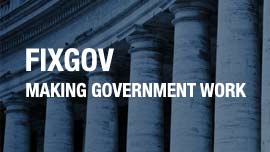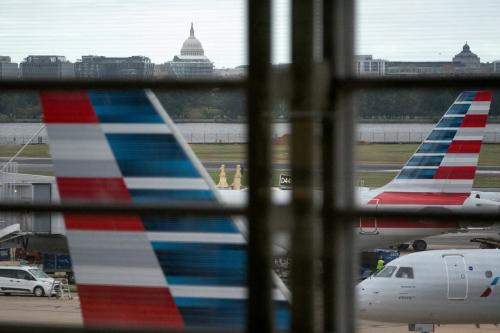Congress may at last be ready to convert our government-run air traffic control system to an autonomous, business-like entity—a step that most other advanced industrial nations have long since taken. The advantage of being a late mover is that U.S. policymakers can learn from other countries in selecting the best governance model for a commercial activity that remains a natural monopoly. Although this choice will be as controversial as it is critical, policymakers should opt for the model that best incentivizes high performance (to paraphrase James Carville, “it’s the incentives, stupid.”).
A 24/7 service “business” trapped in a regulatory agency
As background, the air traffic control system is a network of radar, navigation aids and some 30,000 controllers and engineers whose job it is to keep planes at a safe distance from one another and to guide them along an efficient flight path. The system is operated by the Federal Aviation Administration (FAA), which also regulates the safety of all aspects of civil aviation, including the air traffic control system itself.
Although the FAA’s regulatory functions are inherently governmental, the operation of the air traffic control system is not. In fact, blue ribbon commissions have said for decades that the problems that plague the system—antiquated technology, flight delays and rising unit costs—stem from the effort to run a 24/7, technology-intensive, service “business” from inside of a traditional government agency. Because it relies on appropriated funds, the FAA has historically viewed Congress rather than aircraft operators as its customer. And because Congress holds the purse, FAA decisions on everything from investment to facilities are fair game for political interference. As one example, members opposed to the loss of jobs in their district have long blocked large-scale consolidation of the FAA’s aging and inefficient facilities—a step that would save the system hundreds of millions of dollars a year. The federal budget process is another millstone around the FAA’s neck: because the federal government lacks a capital budget, the FAA cannot borrow against its annual receipts to fund the long-term investments needed to maintain and upgrade the capital-intensive air traffic control system.
In response to these problems, in 1995, the Clinton administration proposed to transfer the air traffic control system to a wholly owned government corporation, the U.S. Air Traffic Services Corporation (USATS), which would be managed by a board of directors and a CEO, financed by user charges that could be leveraged to borrow from the Treasury or (potentially) private capital markets, and overseen by an independent safety regulator (the residual FAA). USATS was dead on arrival in Congress, however, in part because of objections to the proposed financing scheme.
At the time, only a handful of countries (New Zealand, Australia, Germany and the United Kingdom) had moved their air traffic control system outside of the traditional government bureaucracy. Since 1995, another 55 countries have done so. For most countries, the major motivation has been to give the system the tools to operate like a business, including access to the capital markets. Another rationale has been to eliminate the dual mission of the government aviation authority as both regulator and operator of the system, which safety experts believe can pose a conflict of interest. Independent studies of these autonomous, independently regulated air traffic control systems have consistently given them high marks for safety and performance.
Alternative governance models
While the air traffic control system must be able to operate like a business, it remains a natural monopoly. Three governance models have emerged that are designed to provide the needed autonomy while ensuring that the operator does not abuse its monopoly power. The most prevalent model is a government corporation, such as Airways New Zealand or Germany’s DFS (Deutsche Flugsicherung). A second model, exemplified by the United Kingdom’s operator, NATS, is a for-profit corporation that is subject to formal rate-of-return regulation. The third model is a private, non-profit corporation that is governed by a user-dominated stakeholder board. Although Canada’s Nav Canada is the only example of this “user cooperative” approach to air traffic control, it is common in the U.S. utility and agriculture sectors, among others.
The debate in this country is likely to focus on the first and third models (the second, for-profit model, lacks any support here). Since all three models provide for independent safety regulation, the decision should come down to economic performance. In my view, it is not a close call.
User cooperative. The user cooperative approach has shown itself to be superior, in theory and practice. In theory, it achieves an elegant alignment of incentives: because the stakeholder board is dominated by users, it governs the air traffic control system so as to keep costs low and invest in capital at the optimal level. This simple design solution creates an incentive for efficient performance in the absence of competition and it eliminates the incentive for monopoly abuse. Although the government participates as a member of the board (and serves as an independent safety regulator) its involvement in the private system can otherwise be minimal.
Nav Canada’s 19-year track record is practical proof that the approach works as intended. (Had it existed in 1995, I suspect that Nav Canada, rather than New Zealand’s government corporation, would have been the model for USATS.) User charges are a third less in real terms than the ticket tax they replaced in 1998. The system is handling 50 percent more traffic with 30 percent fewer people. And it has fully modernized its equipment with half the prior level of capital expenditure, by bringing software development in-house and relying on commercial off the shelf hardware. (The head of the U.S. National Air Traffic Controllers Association, or NATCA, recently told Congress that he was envious of the equipment used by Canadian controllers.) In fact, Nav Canada now markets its software to other air traffic control providers.
Some stakeholders have questioned whether the Nav Canada model is scalable to an aviation system as large and diverse as the one in this country. However, the U.S. air traffic control system is already large, and there is nothing about a user cooperative approach that limits its scale. To the contrary, the larger and more complex the system, the more important it is to have a commercially driven operator, particularly one with built-in incentives for efficiency. As for “diversity,” meaning the ability of small airports and the general aviation users who rely on them to access the air traffic network, a user cooperative is a non-profit corporation in which the stakeholders are the “owners.” Thus, access is one of the organization’s bottom line goals (along with efficiency and safety).
Government corporation. In contrast to the user cooperative, the government corporation approach to the provision of air traffic control requires ongoing government involvement to achieve the same economic goals. To be sure, this approach has worked well in many countries. However, the structure alone is no guarantee that a government corporation will not seek to abuse its monopoly power. The European Commission has imposed its own regulatory scheme to promote efficiency and discourage monopoly pricing on the part of Europe’s national air traffic control providers, many of which are government corporations.
An even bigger concern in this country may be the potential for unwarranted government involvement. Government corporations in the United States do not have the same degree of political insulation as those in other countries. Consider the U.S. Postal Service, whose efforts to close unneeded facilities have been continually thwarted. If a corporatized air traffic control system is to succeed, it must be shielded from unwarranted external intervention, and it seems doubtful that a government corporation could provide that bulwark.
In this context, Rep. Peter DeFazio, the ranking member of the House Transportation and Infrastructure Committee, has said that Congress needs to create “an independent government corporation for the 21st century,” meaning one that is truly independent. It is a laudable goal—and one deserving of serious thought, more generally. However, I remain skeptical that it is achievable.
Conclusion
Of the 60 air traffic control systems around the world that have been spun off as autonomous, business-like entities, one is measurably outperforming the others. The reason is incentives: Nav Canada’s basic organizational design—management by a stakeholder board that is dominated by the users themselves—creates an incentive for efficiency in the absence of competition and eliminates the incentive for monopoly abuse. A government corporation achieves those same ends, if at all, only by having the government remain involved in the management of the system, which in this country is an invitation to unwarranted intervention. Although this will not be an easy choice for Congress, it should be.
The Brookings Institution is committed to quality, independence, and impact.
We are supported by a diverse array of funders. In line with our values and policies, each Brookings publication represents the sole views of its author(s).




Commentary
Alternative governance models for the air traffic control system: A user cooperative versus a government corporation
April 6, 2015